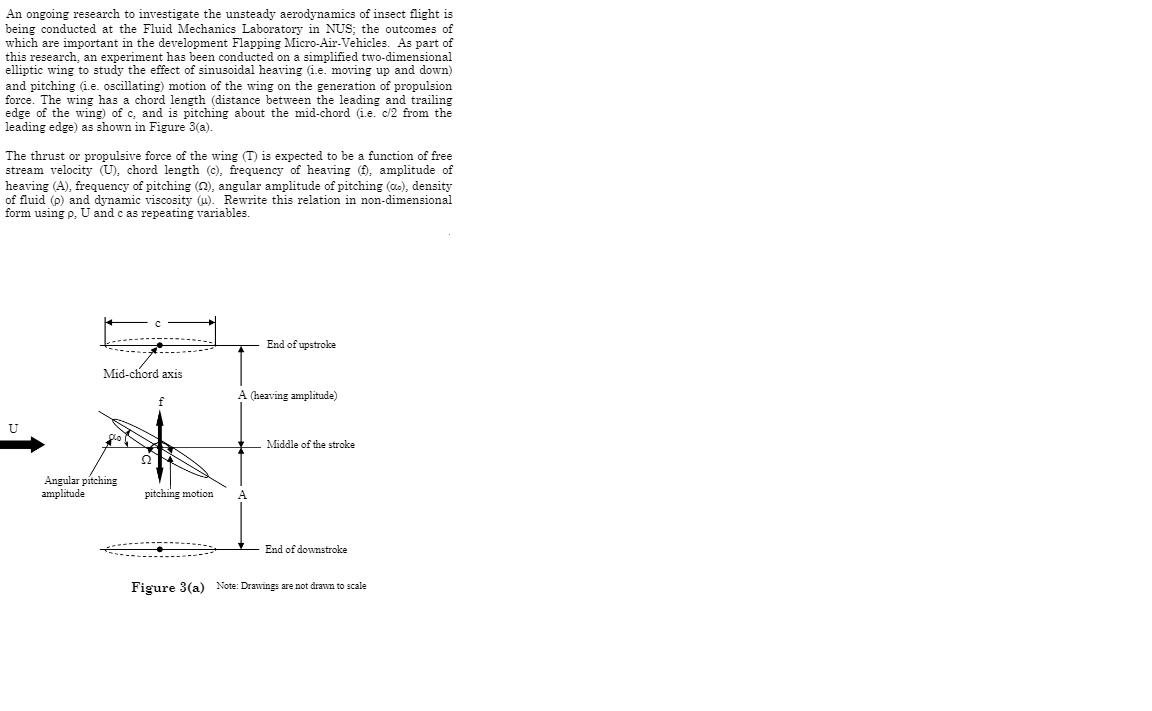An ongoing research to investigate the unsteady aerodynamics of insect flight is being conducted at the Fluid Mechanics Laboratory in NUS; the outcomes of which are important in the development Flapping Micro-Air-Vehicles. As part of this research, an experiment has been conducted on a simplified two-dimensional elliptic wing to study the effect of sinusoidal heaving (1.e. moving up and down) and pitching (Le. oscillating) motion of the wing on the generation of propulsion force. The wing has a chord length (distance between the leading and trailing edge of the wing) of c, and is pitching about the mid-chord (ie. c/2 from the Leading edge) as shown in Figure 3(a). The thrust or propulsive force of the wing (1) is expected to be a function of free stream velocity (U), chord length (c), frequency of heaving (f), amplitude of heaving (A), frequency of pitching (2), angular amplitude of pitching (a.), density of fluid (p) and dynamic viscosity (u). Rewrite this relation in non-dimensional form using p. U and c as repeating variables.
An ongoing research to investigate the unsteady aerodynamics of insect flight is being conducted at the Fluid Mechanics Laboratory in NUS; the outcomes of which are important in the development Flapping Micro-Air-Vehicles. As part of this research, an experiment has been conducted on a simplified two-dimensional elliptic wing to study the effect of sinusoidal heaving (1.e. moving up and down) and pitching (Le. oscillating) motion of the wing on the generation of propulsion force. The wing has a chord length (distance between the leading and trailing edge of the wing) of c, and is pitching about the mid-chord (ie. c/2 from the Leading edge) as shown in Figure 3(a). The thrust or propulsive force of the wing (1) is expected to be a function of free stream velocity (U), chord length (c), frequency of heaving (f), amplitude of heaving (A), frequency of pitching (2), angular amplitude of pitching (a.), density of fluid (p) and dynamic viscosity (u). Rewrite this relation in non-dimensional form using p. U and c as repeating variables.
Principles of Heat Transfer (Activate Learning with these NEW titles from Engineering!)
8th Edition
ISBN:9781305387102
Author:Kreith, Frank; Manglik, Raj M.
Publisher:Kreith, Frank; Manglik, Raj M.
Chapter5: Analysis Of Convection Heat Transfer
Section: Chapter Questions
Problem 5.9P: When a sphere falls freely through a homogeneous fluid, it reaches a terminal velocity at which the...
Related questions
Question

Transcribed Image Text:An ongoing research to investigate the unsteady aerodynamics of insect flight is
being conducted at the Fluid Mechanics Laboratory in NUS; the outcomes of
which are important in the development Flapping Micro-Air-Vehicles. As part of
this research, an experiment has been conducted on a simplified two-dimensional
elliptic wing to study the effect of sinusoidal heaving (i.e. moving up and down)
and pitching (1.e. oscillating) motion of the wing on the generation of propulsion
force. The wing has a chord length (distance between the leading and trailing
edge of the wing) of c, and is pitching about the mid-chord (i.e. c/2 from the
leading edge) as shown in Figure 3(a).
The thrust or propulsive force of the wing (I) is expected to be a function of free
stream velocity (U), chord length (c), frequency of heaving (f), amplitude of
heaving (A), frequency of pitching (2), angular amplitude of pitching (a), density
of fluid (p) and dynamic viscosity (u). Rewrite this relation in non-dimensional
form using p, U and c as repeating variables.
U
Mid-chord axis
Angular pitching
amplitude
22
pitching motion
End of upstroke
A (heaving amplitude)
A
Middle of the stroke
End of downstroke
Figure 3(a) Note: Drawings are not drawn to scale
Expert Solution
This question has been solved!
Explore an expertly crafted, step-by-step solution for a thorough understanding of key concepts.
Step by step
Solved in 2 steps

Knowledge Booster
Learn more about
Need a deep-dive on the concept behind this application? Look no further. Learn more about this topic, mechanical-engineering and related others by exploring similar questions and additional content below.Recommended textbooks for you

Principles of Heat Transfer (Activate Learning wi…
Mechanical Engineering
ISBN:
9781305387102
Author:
Kreith, Frank; Manglik, Raj M.
Publisher:
Cengage Learning

Principles of Heat Transfer (Activate Learning wi…
Mechanical Engineering
ISBN:
9781305387102
Author:
Kreith, Frank; Manglik, Raj M.
Publisher:
Cengage Learning